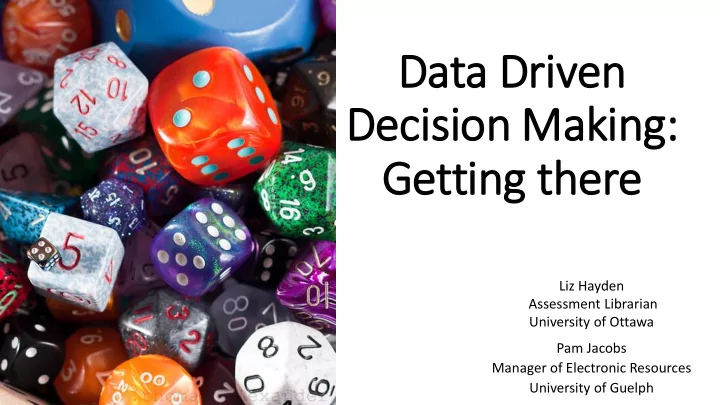

Data Driven Decision Making: Getting there Liz Hayden Assessment Librarian University of Ottawa Pam Jacobs Manager of Electronic Resources University of Guelph
Agenda A. Introduce concept of data driven decision making B. Introduce framework for making data central to decision making C. Work through the framework’s 5 steps 1. Identify your question 2. Develop a plan to collect data 3. Collect the data 4. Analyze the data 5. Generate actionable recommendations
Data Driven Decision Making
Framework for making data central to decision making Process for Data Driven Organizations slide from Sarah Tudesco’s webcast What is a data-driven Academic Library?
Identify your question • What do you want to know? • Be specific • Make it manageable • Ensure it’s actionable
Example Need to cut X dollars from acquisitions budget before fiscal year end. What resources can we cancel with the least impact on our users?
EXERCISE: Identify your question • What do you want to know? • Be specific • Make it manageable • Ensure it’s actionable
Develop a plan to collect necessary data to answer your question
Process for Data Driven Organizations slide from Sarah Tudesco’s webcast What is a data-driven Academic Library?
I need: Example Definition Is there an existing definition or standard that we can work from? Or do we have to write one. If we have to write my own, who My Question: should we have review it? Method Is there an existing method that we can use How should we to match the data properly to the count a virtual visit definition? Or do we have to create one. If to the library? we have to create my own, who should we have review it to ensure it is sound? Data Determine what data should be used for the count that fits with the definition identified. Do we have the data or do we have to gather it?
EXERCISE: Outline a plan to collect necessary data to answer your question • Environment scan -Check the literature -Identify existing frameworks, data sets • Based on some of what you identified above, begin listing your data needs -Brainstorm (refer to your data sources list for inspiration) -Begin to structure/refine the list • Experts I can talk to: -In my library (data librarian; social science librarians & grad students) -On my campus (Institutional research and planning office) -External (Assessment colleagues, authors of results of environment scan)
Collect the Data
Extract from existing systems
Generate data
Example Extract: • Usage reports from vendor admin sites and Scholars Portal • Link resolver clickthrough statistics from Link resolver admin site • Cost data from acquisitions module of ILS Request: • LibGuide clickthrough statistics from LibGuides coordinator
EXERCISE: Collect the data How will you go about collecting the data you need to answer your question?
Analyze the data Sampling distribution Variables Confidence intervals Constants Pearson r Population VS Sample Multiple regression analysis Hypothesis testing Levels Descriptive stats of scale
Analysis of Virtual Visits (Summary data 2012-15) Webpage (A) GA (B) GA Referrals to be (A) – (B) Session removed from (A) GA Count Session Count Library Website Home page 6,000,000 6,000,000 Search+ 1,500,000 900,000 600,000 Endeca 900,000 600,000 300,000 LibGuides 600,000 300,000 300,000 uO Research 500,000 100,000 400,000 Classic Catalogue 500,000 300,000 200,000 Total electronic visits 7,800,000 (C) Less Total Log-ins from LabStats data 1,500,000 Total visits that were only virtual & not included in gate count stat 6,300,000
2,500,000 Example: 2,000,000 • Our assumption: 1,500,000 -Gate count decrease -Virtual Visit increase 1,000,000 500,000 - 2011-12 2012-13 2013-14 2014-15 Gate Count Virtual
2,500,000 Example: 2,000,000 • Our data: 1,500,000 -Gate count decrease -Virtual Visit decrease 1,000,000 500,000 - 2011-12 2012-13 2013-14 2014-15 Gate Count Virtual
EXERCISE: Review the items listed in Explore & Analyze. Which do you think will be the most challenging for you? Discuss actions you can take now to move forward. Explore and Analyze 1. Gather the results 2. What is the data telling you? 3. Test the validity of the data
Use that analysis to generate actionable recommendations • Communicate your results • Aim for simplicity & clarity • Know your audience(s) and tailor your message(s) • Put your results in context • You may not be able to make recommendations at this stage • Further explore the meaning behind your analysis – may require additional data sources and additional analysis
5 Tips for communicating data 1. Plan: Know What You Want to Say 2. Prepare: Be Ready 3. Frame: Context is Key 4. Simplify: Less is More 5. Engage: It's Useless If No One Knows It Exists • Source: http://www.everydayanalytics.ca/2012/10/top-5-tips-for- communicating-data.html
Source: http://www.forbes.com/sites/tomiogeron/2012/02/02/does-ios-crash-more-than-android-a-data-dive/
Source: http://exceluser.com/blog/1152/oh-no-chart-junk-from-the-wall-street-journal.html
Framework for making data central to decision making Process for Data Driven Organizations slide from Sarah Tudesco’s webcast What is a data-driven Academic Library?
EXERCISE: Use that analysis to generate actionable recommendations • Pretend you have the results of your analysis and you can identify one or more actionable recommendations as a result. • Who do you need to communicate this information to? How will you do so?
Recommend
More recommend